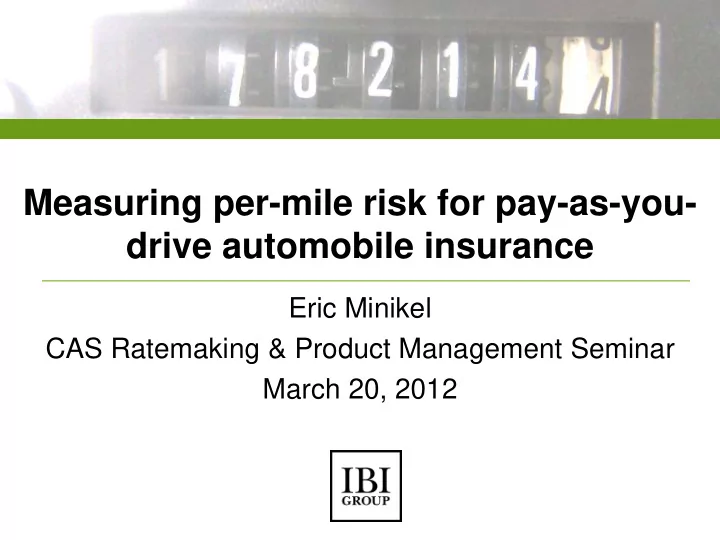

Measuring per-mile risk for pay-as-you- drive automobile insurance Eric Minikel CAS Ratemaking & Product Management Seminar March 20, 2012
Professor Joseph Ferreira, Jr. and Eric Minikel “Measuring per-mile risk for pay-as- you-drive automobile insurance” Full text of CLF report: goo.gl/exuSp or Google “CLF PAYD” Feasibility Assessment
Presentation Outline • Background • Datasets • Per-mile risk modeling • Equity and environmental impacts • Conclusions Feasibility Assessment
Background Feasibility Assessment
What is pay-as-you-drive insurance? • Cents-per-mile rate • Customers billed for actual miles driven • Potential benefits – Improved actuarial accuracy – Opportunity for consumers to save money – Reduced negative externalities (congestion, accidents, pollution) Feasibility Assessment
Status of pay-as-you-drive insurance in U.S. • MileMeter offers true cents-per-mile coverage in Texas • Verified low-mileage or black box discount programs available from a variety of providers in many states Feasibility Assessment
Status of pay-as-you-drive insurance in U.S. • 50 state regulators • 16 prohibit PAYD – Including Massachusetts • Many regulatory barriers to introduction and adoption of PAYD Feasibility Assessment
Our contribution • Assess risk-mileage relationship with largest disaggregate dataset to date • Classifies drivers by class and territory • Characterize rate levels and relativities • Model economic and environmental impacts Feasibility Assessment
Dataset Feasibility Assessment
Data sources Data released by Massachusetts Executive Office of Energy and Environmental Affairs (EOEEA) • Odometer readings from mandated annual safety checks (Mass RMV) • Insurance policy and claims data from Mass “statistical plan” reporting (Commonwealth Automobile Reinsurers) • Original dataset: goo.gl/la5fJ • Analytic dataset: goo.gl/GiVxW Feasibility Assessment
Data processing • Estimate mileage from odometer readings • Estimate pure premiums from losses plus outstanding reserves • Join on VIN • Consider only compulsory coverage categories and levels • Divide drivers into coarse rate groups (five classes, six territories) • Parse VINs to obtain fuel economy estimates Feasibility Assessment
Five classes Feasibility Assessment
Six territories Feasibility Assessment
Sample size Policy year 2006: • 3M car-years of earned exposure – 71% of private, insured autos in Massachusetts • $502M in claims • 34B miles Feasibility Assessment
Per-mile risk modeling Feasibility Assessment
Pure premium vs. ann. mileage (all drivers) Feasibility Assessment
Pure premium vs. ann. mileage (all drivers) Feasibility Assessment
Reasons for non-proportionality • All drivers are considered together • Regression to the mean • Experience and driving habits Feasibility Assessment
Pure premium vs. ann. mileage (all drivers) Feasibility Assessment
Pure premium vs. ann mileage (T3 adults) Feasibility Assessment
Pure premium vs. ann. mileage (T3 adults 90%+) Feasibility Assessment
Pure premium vs. ann. mileage (all drivers) Feasibility Assessment
Pure premium vs. ann mileage (T3 adults) Feasibility Assessment
Pure premium vs. ann. mileage (T3 adults 90%+) Feasibility Assessment
Regression analysis • Poisson regression – Respects “rare event” nature of accidents – Allows true disaggregate analysis – Results in an exponential model of the risk- mileage relationship Feasibility Assessment
Poisson regression #1 Pure premium = $6.53 * (ann_miles 0.36 ) Feasibility Assessment
Poisson regression #2 • Pure premium = $2.35 * (ann_miles 0.40 ) * (class relativity) * (terr relativity) • Limitation: relativities only affect magnitude of curve, not its shape. Feasibility Assessment
Poisson regression #3 • T3 adults only • Pure premium=$1.70×ann_miles 0.46 • Exponent is higher for any one class- territory group than for all class-territory groups together • Limitation: regression to the mean is still present Feasibility Assessment
Poisson regression #4 • T3 adults only • 90% or greater overlap between mileage and policy periods–reliable mileage estimates • Pure premium= $0.74×ann_miles 0.54 Feasibility Assessment
Poisson regression conclusions • Mileage-risk relationship may be even stronger than we observe here as industry would use: – Finer rate groups – More rating factors – Better mileage estimates Feasibility Assessment
Poisson regression conclusions • Mileage and risk are strongly correlated • Relationship becomes stronger and more nearly proportional when controlling for class, territory and RTM. Feasibility Assessment
Regression analysis • Linear regression – Shows how much of variation is explained by different factors – Results in a flat rate plus cents-per-mile model, a more realistic model of how PAYD might be priced Feasibility Assessment
Linear regression • Vehicles aggregated into “bins” by class, territory and 500-mile annual mileage range; weighted by number of vehicles Adjusted R 2 Factors Mileage .09 Class and territory .57 Mileage, class and .72 territory Feasibility Assessment
Linear regression conclusions • The whole is better than the sum of the parts – .72 > .09 + .57 – Mileage is a better predictor of risk when paired with some control (class and territory) on where and how miles are being driven Feasibility Assessment
Per-mile risk assessment conclusions • Mileage is correlated with risk • Correlation is stronger with class-territory control • PAYD could be priced with individual per mile rates based on class and territory Feasibility Assessment
Equity and environmental impacts Feasibility Assessment
VMT reduction model • Model consumer response to increase in marginal cost of driving a mile due to PAYD • Modeled for each individual vehicle based on its annual mileage, fuel economy and insurance rate group • Constant elasticity of -0.15 assumed Feasibility Assessment
VMT reduction model • Results–if all MA drivers adopted PAYD: – 9.5% aggregate VMT reduction if pricing is strictly per mile, – 5.0% if a flat fee covers first 2000 miles, with a lower per mile fee thereafter Feasibility Assessment
Fairness and equity impacts Assumption: PAYD would be offered as a consumer option Key findings: • No geographic impacts • Cross-subsidy alleviated • Congestion and safety benefits • Controllable individual factors improve fairness Feasibility Assessment
Conclusions Feasibility Assessment
Summary of key findings • PAYD is actuarially justified • PAYD is equitable and fair • Statewide adoption would result in VMT reductions of 5 – 9.5% Feasibility Assessment
Policy implications • Regulators should support PAYD • Consumer protections needed for: – Consumer awareness – Uninsured driving – ‘Tracking data’ Feasibility Assessment
Eric Minikel <eric.minikel@ibigroup.com> Professor Joseph Ferreira <jf@mit.edu> Special thanks to: b Feasibility Assessment
Recommend
More recommend